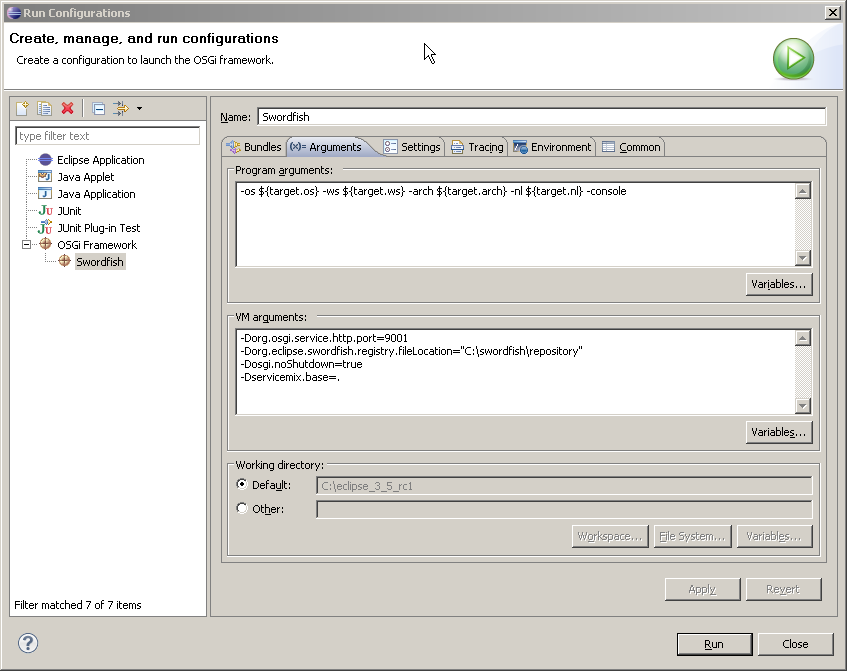Notice: this Wiki will be going read only early in 2024 and edits will no longer be possible. Please see: https://gitlab.eclipse.org/eclipsefdn/helpdesk/-/wikis/Wiki-shutdown-plan for the plan.
Difference between revisions of "Swordfish Documentation: Running Target Platform"
| (38 intermediate revisions by 5 users not shown) | |||
| Line 1: | Line 1: | ||
==Running Swordfish Target Platform== | ==Running Swordfish Target Platform== | ||
| − | This section contains | + | This section contains instructions on setting up the Swordfish Target Platform produced by the headless build.<br/> |
| − | For more information about Swordfish headless | + | For more information about Swordfish headless builds, see [[Swordfish_Documentation:_Creating_Headless_Build|Creating a headless build]]. |
==Prerequisites== | ==Prerequisites== | ||
| − | + | Eclipse Galileo (Eclipse 3.5) build or later. The examples described here are based on Eclipse 3.5. | |
==Setting up Target Platform== | ==Setting up Target Platform== | ||
| − | + | To run Swordfish Target Platform do the following: | |
<ol> | <ol> | ||
| − | <li>Create a new Target Platform definition | + | <li>Create a new Target Platform definition. Click <b>File</b> > <b>New</b> > <b>Other...</b> > <b>Target Definition</b><br/>or go to <b>Preferences</b> > <b>Plug-in Development</b> > <b>Target Platform</b> and click <b>Add...</b></li> |
| + | <li>Add the location (path) of the built Swordfish plug-ins to the list of locations presented in the definition.<br/> | ||
[[Image:Target_definition_site.png]]</li><br/> | [[Image:Target_definition_site.png]]</li><br/> | ||
| − | <li>Add to the platform definition location of Equinox bundles necessary to run target platform.<br/> | + | <li>Add to the platform definition location of Equinox the bundles that are necessary to run the target platform.<br/> |
| − | <b> | + | When the build process successfully ends, you can find these bundles in the <b>platform</b> directory of org.eclipse.swordfish.build project. <br/> |
| − | + | ||
[[Image:Target_definition.png]]<br/><br/> | [[Image:Target_definition.png]]<br/><br/> | ||
| − | Go to the <b>Content</b> tab and select bundles | + | Go to the <b>Content</b> tab and select the bundles listed in <tt>c:</tt> as shown in this figure.<br> |
| − | [[Image: | + | This means that all bundles from the target platform as well as the Eclipse Equinox bundles must be selected. |
| + | [[Image:Target_content1.png]]</li><br/> | ||
| − | <li>Configure Eclipse to use Swordfish target platform. | + | <li>Configure Eclipse to use the Swordfish target platform.</li> |
| − | + | <ol> | |
| + | <li>Click <b>Window</b> > <b>Preferences</b> > <b>Target Platform</b> and set the newly created definition as active target platform.<br/> | ||
[[Image:Target_platform.png]]</li><br/> | [[Image:Target_platform.png]]</li><br/> | ||
| − | <li> | + | <li>In the <b>Run Configurations...</b> dialog create a new OSGi configuration based on Swordfish target platform.<br/> |
[[Image:Launch_configuration.png]]</li><br/> | [[Image:Launch_configuration.png]]</li><br/> | ||
| − | + | </ol> | |
| − | <li>Switch to the <b>Arguments</b> tab and | + | <li>Switch to the <b>Arguments</b> tab and type the following VM arguments:<br/> |
<pre> | <pre> | ||
-Dorg.osgi.service.http.port=9001 | -Dorg.osgi.service.http.port=9001 | ||
| Line 33: | Line 35: | ||
-Dosgi.noShutdown=true | -Dosgi.noShutdown=true | ||
-Dservicemix.base=. | -Dservicemix.base=. | ||
| − | -Dorg.osgi.framework.system.packages="com.sun.jimi.core, com.sun.net.ssl, com.sun.net.ssl.internal.ssl, com.sun.org.apache.xalan.internal, | + | -Dorg.osgi.framework.system.packages="com.sun.jimi.core,com.sun.net.ssl,com.sun.net.ssl.internal.ssl, |
| − | com.sun.org.apache.xalan.internal.res, com.sun.org.apache.xalan.internal.xsltc.trax, com.sun.org.apache.xerces.internal.dom, | + | com.sun.org.apache.xalan.internal,com.sun.org.apache.xalan.internal.res,com.sun.org.apache.xalan.internal.xsltc.trax, |
| − | com.sun.org.apache.xerces.internal.jaxp, com.sun.org.apache.xerces.internal.xni, com.sun.org.apache.xml.internal, com.sun.org.apache.xml.internal.utils, | + | com.sun.org.apache.xerces.internal.dom,com.sun.org.apache.xerces.internal.jaxp,com.sun.org.apache.xerces.internal.xni, |
| − | com.sun.org.apache.xpath.internal, com.sun.org.apache.xpath.internal.jaxp, com.sun.org.apache.xpath.internal.objects, com.sun.xml.fastinfoset.dom, | + | com.sun.org.apache.xml.internal,com.sun.org.apache.xml.internal.utils,com.sun.org.apache.xpath.internal, |
| − | com.sun.xml.fastinfoset.sax, com.sun.xml.fastinfoset.stax, javax.annotation, javax.annotation.security, javax.crypto, javax.crypto.interfaces, | + | com.sun.org.apache.xpath.internal.jaxp,com.sun.org.apache.xpath.internal.objects,com.sun.xml.fastinfoset.dom, |
| − | javax.crypto.spec, javax.imageio, javax.imageio.metadata, javax.imageio.stream, javax.jms, javax.management, javax.management.loading, | + | com.sun.xml.fastinfoset.sax,com.sun.xml.fastinfoset.stax,javax.annotation,javax.annotation.security,javax.crypto, |
| − | javax.management.modelmbean, javax.management.remote, javax.naming, javax.naming.directory, javax.naming.spi, javax.net, javax.net.ssl, javax.rmi, | + | javax.crypto.interfaces,javax.crypto.spec,javax.imageio,javax.imageio.metadata,javax.imageio.stream,javax.jms, |
| − | javax.security.auth, javax.security.auth.callback, javax.security.auth.login, javax.security.auth.spi, javax.security.auth.x500, javax.security.cert, | + | javax.management,javax.management.loading,javax.management.modelmbean,javax.management.remote,javax.naming, |
| − | javax.security.sasl, javax.sql, javax.swing, javax.swing.event, javax.xml.datatype, | + | javax.naming.directory,javax.naming.spi,javax.net,javax.net.ssl,javax.rmi,javax.security.auth, |
| − | javax.xml.transform.dom, javax.xml.transform.sax, javax.xml.transform.stream, javax.xml.validation, javax.xml.xpath, org.jvnet.fastinfoset, | + | javax.security.auth.callback,javax.security.auth.login,javax.security.auth.spi,javax.security.auth.x500, |
| − | org.jvnet.staxex, org.omg.CORBA, org.omg.CosNaming, org.w3c.dom, org.w3c.dom.bootstrap, org.w3c.dom.ls, org.w3c.dom.traversal, org.xml.sax, | + | javax.security.cert,javax.security.sasl,javax.sql,javax.swing,javax.swing.event,javax.xml.datatype,javax.xml.parsers, |
| − | org.xml.sax.ext, org.xml.sax.helpers, sun.misc, sun.security.provider,javax.activation, org.omg.CORBA.TypeCodePackage, org.omg.CORBA.portable, | + | javax.xml.namespace,javax.xml.transform,javax.xml.transform.dom,javax.xml.transform.sax,javax.xml.transform.stream, |
| − | org.omg.PortableServer, org.omg.PortableServer.POAPackage, javax.swing.border, org.w3c.dom.events, org.w3c.dom.html, org.w3c.dom.ranges" | + | javax.xml.validation,javax.xml.xpath,org.jvnet.fastinfoset,org.jvnet.staxex,org.omg.CORBA,org.omg.CosNaming, |
| + | org.w3c.dom,org.w3c.dom.bootstrap,org.w3c.dom.ls,org.w3c.dom.traversal,org.xml.sax,org.xml.sax.ext,org.xml.sax.helpers, | ||
| + | sun.misc,sun.security.provider,javax.activation,org.omg.CORBA.TypeCodePackage,org.omg.CORBA.portable, | ||
| + | org.omg.PortableServer,org.omg.PortableServer.POAPackage,javax.swing.border,org.w3c.dom.events,org.w3c.dom.html,org.w3c.dom.ranges" | ||
</pre> | </pre> | ||
| − | + | <ol> | |
| − | + | <li>The value of <tt>org.osgi.service.http.port</tt> must be set to 9001 - the default port that the remote resolver uses to connect to the Swordfish registry.</li> | |
| − | </li>< | + | <li>The next property <tt>org.eclipse.swordfish.registry.fileLocation</tt> must point to the directory where all the WSDL files that need to be loaded by the registry are placed.</li> |
| + | <li>The property <tt>osgi.noShutdown</tt> is the Eclipse Equinox (OSGI) specific container. Its value must be set to <tt>true</tt> because Equinox shuts down by default after starting up if it does not find an Eclipse application. For details on this issue, see [http://www.eclipse.org/equinox/documents/quickstart.php Equinox Quick Start].</li> | ||
</ol> | </ol> | ||
| + | The optional property <tt>org.eclipse.swordfish.registry.url</tt> can be used to point to the running Swordfish Registry instance e.g.<br/> | ||
| + | <pre> | ||
| + | -Dorg.eclipse.swordfish.registry.url=http://localhost:9002/anotherRegistry | ||
| + | </pre> | ||
| + | <p>For more information about Swordfish Registry properties, see [[Swordfish_Documentation:_Launching_Service_Registry|Launching the Service Registry]].</p> | ||
| + | [[Image:Launch_configuration_vm_params.png]] | ||
| + | </li></ol> | ||
| + | <br/> | ||
| + | |||
| + | ==Starting the Target Platform== | ||
| + | <p>You may use Swordfish samples to check if the Swordfish target platform can be successfully started.</p> | ||
| + | <p>To check if the target platform starts successfully:</p> | ||
| + | <ol> | ||
| + | <li>Launch the target platform.</li> | ||
| + | <li>Start a Web browser</li> | ||
| + | <li>Enter the following URL: http://localhost:8192/cxfsample/?wsdl</li> | ||
| + | </ol> | ||
| + | <p>If the platform successfully starts, you see a WSDL file containing a description of the sample <em>BookingService</em>.</p> | ||
---------------- | ---------------- | ||
[[Swordfish_Documentation |Swordfish Documentation Home]] <br/> | [[Swordfish_Documentation |Swordfish Documentation Home]] <br/> | ||
[[Swordfish | Swordfish Wiki Home]] <br/> | [[Swordfish | Swordfish Wiki Home]] <br/> | ||
Latest revision as of 06:41, 30 September 2009
Contents
Running Swordfish Target Platform
This section contains instructions on setting up the Swordfish Target Platform produced by the headless build.
For more information about Swordfish headless builds, see Creating a headless build.
Prerequisites
Eclipse Galileo (Eclipse 3.5) build or later. The examples described here are based on Eclipse 3.5.
Setting up Target Platform
To run Swordfish Target Platform do the following:
- Create a new Target Platform definition. Click File > New > Other... > Target Definition
or go to Preferences > Plug-in Development > Target Platform and click Add... - Add the location (path) of the built Swordfish plug-ins to the list of locations presented in the definition.
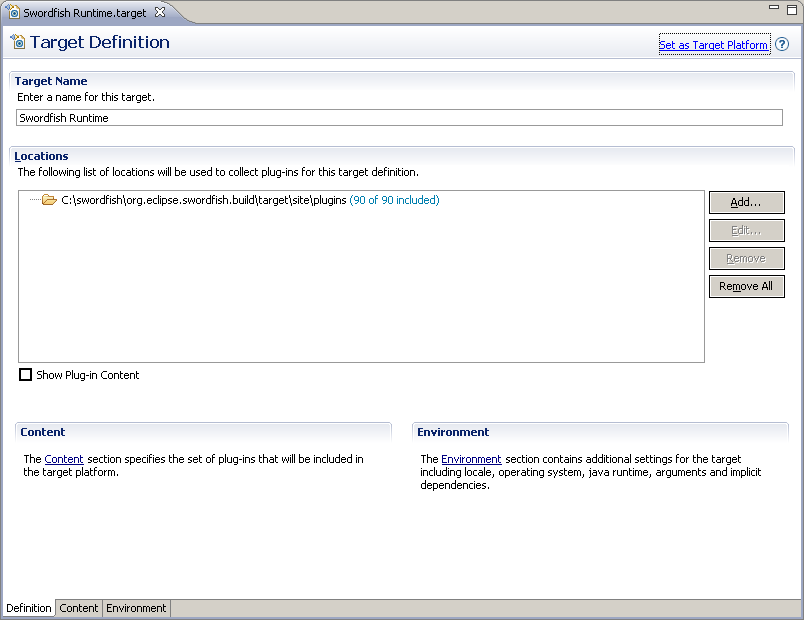
- Add to the platform definition location of Equinox the bundles that are necessary to run the target platform.
When the build process successfully ends, you can find these bundles in the platform directory of org.eclipse.swordfish.build project.
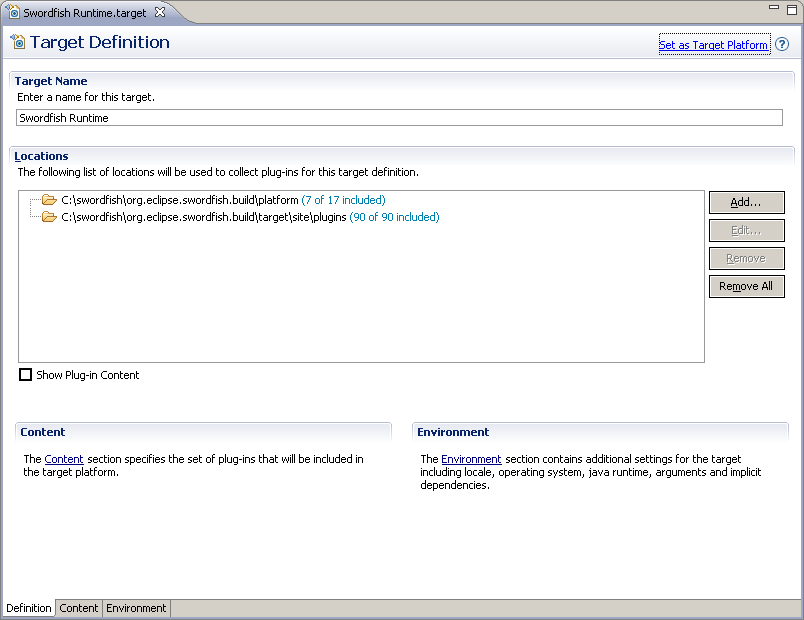
Go to the Content tab and select the bundles listed in c: as shown in this figure.
This means that all bundles from the target platform as well as the Eclipse Equinox bundles must be selected.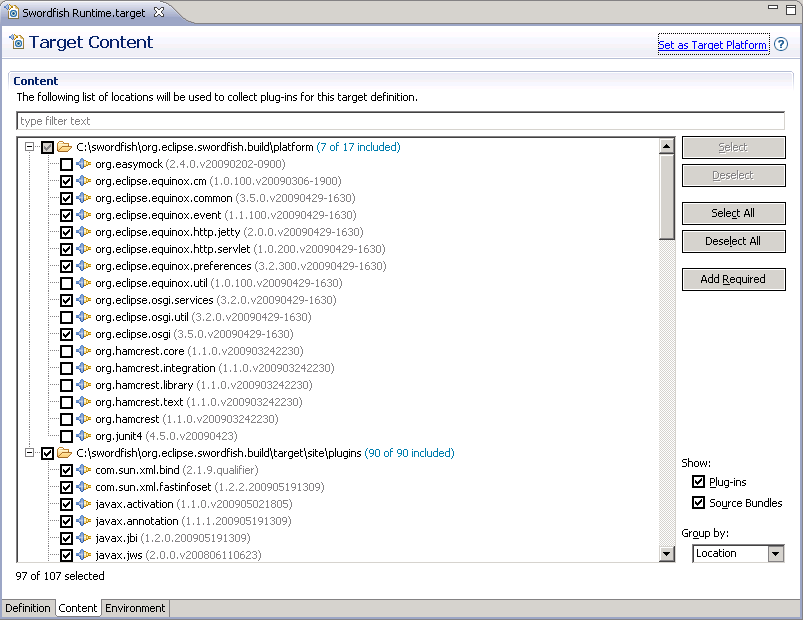
- Configure Eclipse to use the Swordfish target platform.
- Click Window > Preferences > Target Platform and set the newly created definition as active target platform.
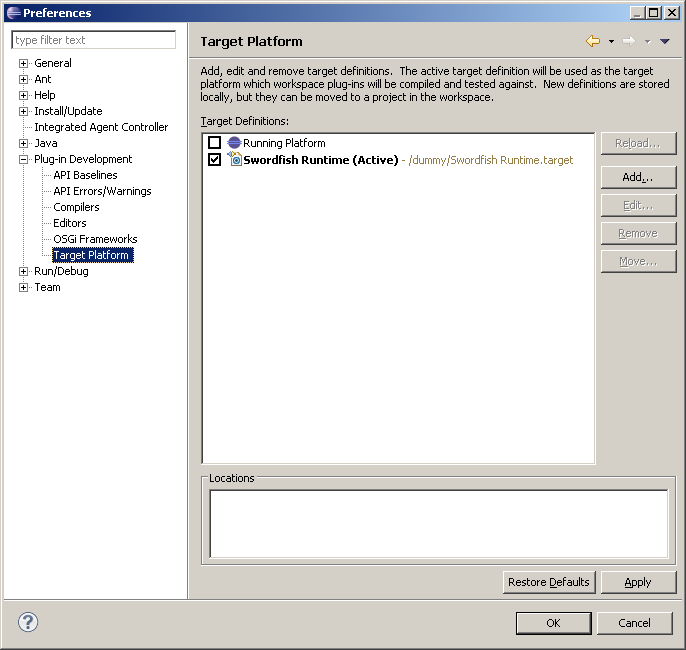
- In the Run Configurations... dialog create a new OSGi configuration based on Swordfish target platform.
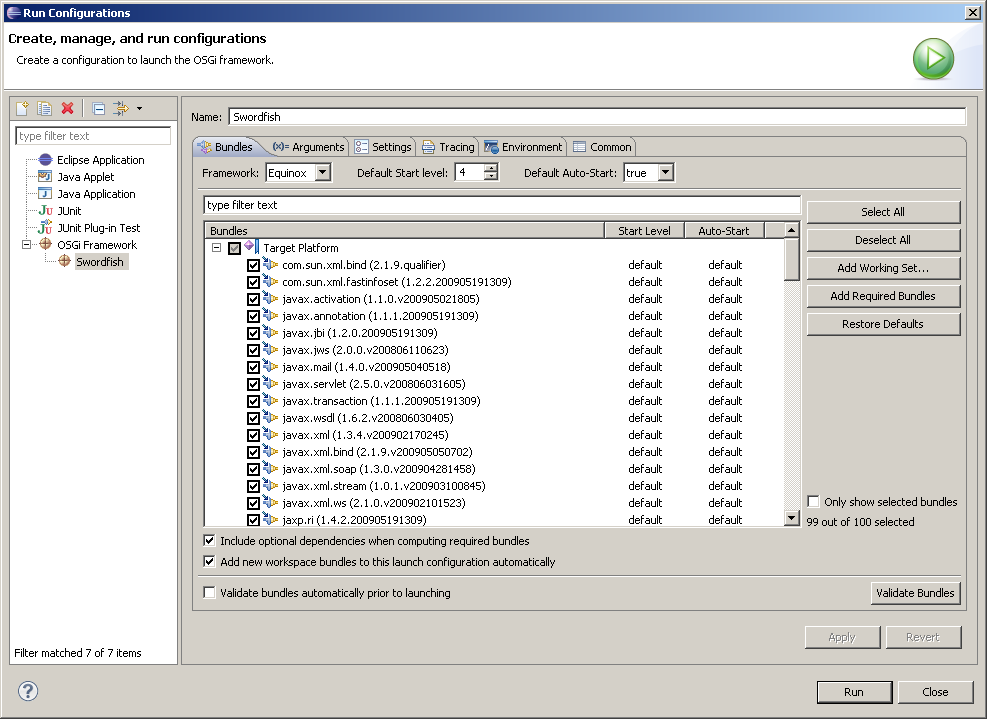
- Switch to the Arguments tab and type the following VM arguments:
-Dorg.osgi.service.http.port=9001 -Dorg.eclipse.swordfish.registry.fileLocation="C:\swordfish\repository" -Dosgi.noShutdown=true -Dservicemix.base=. -Dorg.osgi.framework.system.packages="com.sun.jimi.core,com.sun.net.ssl,com.sun.net.ssl.internal.ssl, com.sun.org.apache.xalan.internal,com.sun.org.apache.xalan.internal.res,com.sun.org.apache.xalan.internal.xsltc.trax, com.sun.org.apache.xerces.internal.dom,com.sun.org.apache.xerces.internal.jaxp,com.sun.org.apache.xerces.internal.xni, com.sun.org.apache.xml.internal,com.sun.org.apache.xml.internal.utils,com.sun.org.apache.xpath.internal, com.sun.org.apache.xpath.internal.jaxp,com.sun.org.apache.xpath.internal.objects,com.sun.xml.fastinfoset.dom, com.sun.xml.fastinfoset.sax,com.sun.xml.fastinfoset.stax,javax.annotation,javax.annotation.security,javax.crypto, javax.crypto.interfaces,javax.crypto.spec,javax.imageio,javax.imageio.metadata,javax.imageio.stream,javax.jms, javax.management,javax.management.loading,javax.management.modelmbean,javax.management.remote,javax.naming, javax.naming.directory,javax.naming.spi,javax.net,javax.net.ssl,javax.rmi,javax.security.auth, javax.security.auth.callback,javax.security.auth.login,javax.security.auth.spi,javax.security.auth.x500, javax.security.cert,javax.security.sasl,javax.sql,javax.swing,javax.swing.event,javax.xml.datatype,javax.xml.parsers, javax.xml.namespace,javax.xml.transform,javax.xml.transform.dom,javax.xml.transform.sax,javax.xml.transform.stream, javax.xml.validation,javax.xml.xpath,org.jvnet.fastinfoset,org.jvnet.staxex,org.omg.CORBA,org.omg.CosNaming, org.w3c.dom,org.w3c.dom.bootstrap,org.w3c.dom.ls,org.w3c.dom.traversal,org.xml.sax,org.xml.sax.ext,org.xml.sax.helpers, sun.misc,sun.security.provider,javax.activation,org.omg.CORBA.TypeCodePackage,org.omg.CORBA.portable, org.omg.PortableServer,org.omg.PortableServer.POAPackage,javax.swing.border,org.w3c.dom.events,org.w3c.dom.html,org.w3c.dom.ranges"
- The value of org.osgi.service.http.port must be set to 9001 - the default port that the remote resolver uses to connect to the Swordfish registry.
- The next property org.eclipse.swordfish.registry.fileLocation must point to the directory where all the WSDL files that need to be loaded by the registry are placed.
- The property osgi.noShutdown is the Eclipse Equinox (OSGI) specific container. Its value must be set to true because Equinox shuts down by default after starting up if it does not find an Eclipse application. For details on this issue, see Equinox Quick Start.
The optional property org.eclipse.swordfish.registry.url can be used to point to the running Swordfish Registry instance e.g.
-Dorg.eclipse.swordfish.registry.url=http://localhost:9002/anotherRegistry
For more information about Swordfish Registry properties, see Launching the Service Registry.
Starting the Target Platform
You may use Swordfish samples to check if the Swordfish target platform can be successfully started.
To check if the target platform starts successfully:
- Launch the target platform.
- Start a Web browser
- Enter the following URL: http://localhost:8192/cxfsample/?wsdl
If the platform successfully starts, you see a WSDL file containing a description of the sample BookingService.

